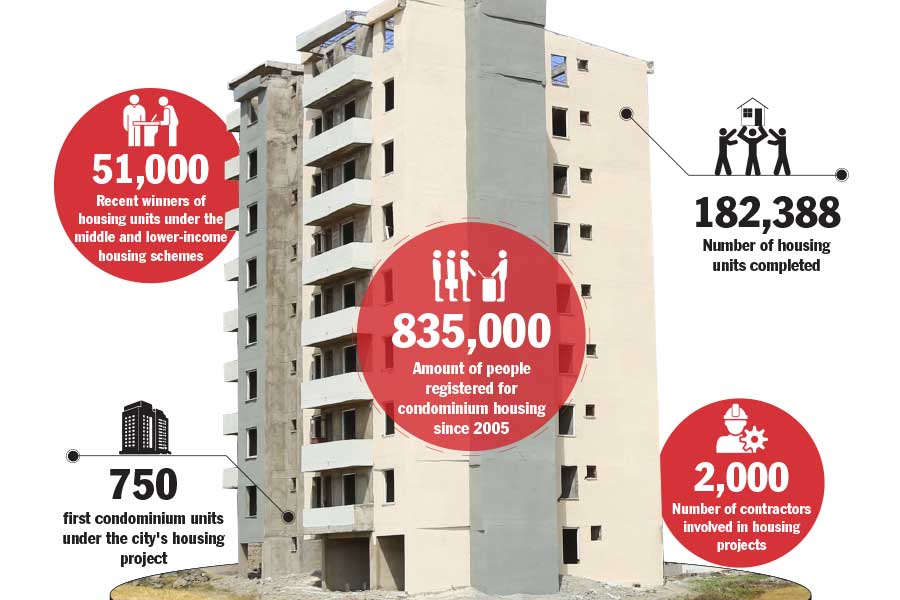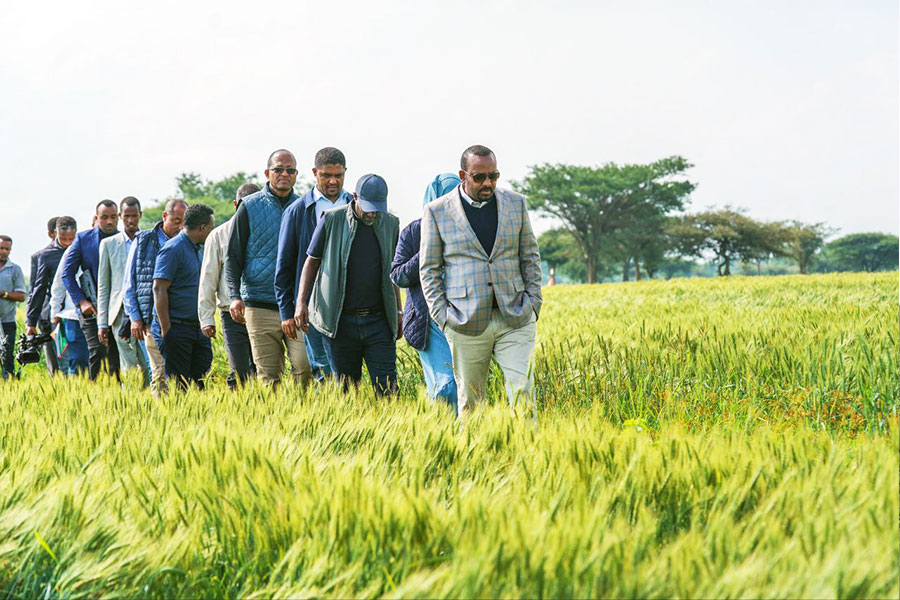
Farming was a calling to Getachew Tessema, who left his hometown Wonji, central Ethiopia, 54 years ago in search of work. Years later, he landed in Afar Regional State and slowly got enough resources together to start farming there.
“I always had the vision to be a farmer,” said Getachew. “What could be better than being self-sufficient? It’s just a matter of waiting for the right circumstances.”
The right circumstances have come and gone since Getachew started farming over two decades ago. At the height of his career, he rented 30hct from the local people, harvesting cotton. Since then, years of seasonal floods have washed away most of Getachew’s harvest.
Floods are common in Afar, a lowland area that makes part of the Awash River Basin, one of Ethiopia’s most important river basins.
It is also one of the three basins federal authorities have selected to experiment with “summer harvesting”, pinning their hopes for Ethiopia to become a net wheat exporter next year. Along with maize and teff, wheat is the most used grain for food covering 14pc of consumption. Ethiopia has a per capita wheat consumption of 64kg.
The federal initiative is a national ambition aspiring to reverse course from an image of Ethiopia as a poster child of drought and famine to self-sufficiency, and eventually a land of surplus. It is a program launched two years ago on a 500hcts land along the Shebele River in Somali Regional State.
Officials at the Ministry of Agriculture plan and their experts plot to expand this exponentially to reach over 30pc of the 107 million quintal wheat harvest planned for next year, surpassing demand by 10 million quintals. The surplus is hoped to bring the country no less than 390 million dollars from exports. If successful, it will also save Ethiopia 320 million dollars spent two years ago importing one million tons of wheat from overseas markets.
The wheat harvested from summer irrigations on the Shebele, Omo and Awash basins could be a grand ambition for the country and its leaders. But the buzz has also motivated small-scale commercial farmers like Getachew to try something new this year.
Though he only has one hectare left to work with, Getachew plans to sow wheat between his regular cropping seasons, belg and meher. The time he used to spend on storing and selling cotton between these seasons, he is now sowing summer wheat.
Summer wheat has become the transition grain at Getachew’s farm. In the grander plans of the government, it is designed to pull the country from wheat imports to export. The social media threads of senior federal and regional government heads - from the Prime Minister to his Agricultural Minister and Oromia Regional State chief to his counterpart in Somali Regional State - are crammed with photos and video clips of lush green lands. They urge their followers that success is within grasp.
Lowland areas like Afar Regional State, idle during summer and where the usually hot weather cools down, make an ideal location to sow wheat. The region is expected to produce 2.5 million tonnes of wheat this coming year. At roughly 10,000hct, the region also has the largest areas of private farms working on irrigated wheat.
The lands here have their set of challenges, however. The biggest of which is floods. But farmers here are facing overwhelming weeds this year. In a predominantly agro-pastoralist society, harvest is also lost to cattle looking for grazing land.
“It’s more profitable for us to add another round of harvest, but it will take more resources,” Getachew told Fortune. “The cattle which are normally banned from the farms during the regular cropping season come back. We’re expected to put up our fences for this season.”
Much of Getachew’s plan seems to rest on hope as the country does the country’s. He anticipates floods do not take over his harvest, that the weeds will stay manageable and, most importantly, the crop will yield.
The government’s plan for wheat import substitution rests mainly on two strategies; summer irrigation and promoting cluster farming. Close to 60pc of the massive increase in wheat harvest is expected to come from millions of smallholder farmers.
Lome Wereda, about 100Km east of Addis Abeba, is where farmers are urged by local authorities to begin practicing cluster farming. It is a way of adjoining strips of land usually left to mark borders between farms. The authorities hope that if many of the 18 million farmers put together the pieces of land, the combined effect on productivity can be enormous. That way, they believe they can meet their ambitious target of ploughing over one million hectares by next year, more than double what they say was farmed last year.
Most of the farmland surrounding Lome Wereda along a major logistic and industrial hub sat empty a few months ago. The area is ideal for agriculture, particularly irrigation farming, as it lies in the Great Rift Valley, surrounded by major rivers such as Awash, Wedecha, and Belbela. However, it had been two months since farmers in Lome’s 35 kebeles harvested their crops.
Girma Tesema, 65, depends on water from the Modjo River, a tributary of the Awash, to grow wheat on two hectares under the cluster and off-season farming initiatives. He and several farmers in the area harvest twice a year through irrigation.
He lives in Dengugi Kebele, where he and his fellow farmers have been pleading with local authorities to divert water from the Awash River.
“They said it’s beyond their mandate,” he told Fortune.
Girma inherited six hectares of land from his parents. Farming is his sole means of providing and paying for the education of his nine children. One of his sons, Matios, opened a dental clinic in Addis Abeba after graduating from Tikur Anbess (Black Lion) Hospital.
Two years ago, local administrators convinced Girma to join the cluster and off-season farming initiatives. He and nearly 1,700 farmers in Dengugi Kebele have thus far signed up for the initiative launched three years ago.
“We’re eager to begin,” he said.
But Girma’s productivity has not improved in the time since. He used to harvest up to 20qtl of wheat on each hectare before he signed up and sold half of his crop for 2,800 Br a quintal. Last year, his productivity slumped by half. Part of the reason for the decline is the successive desert locust invasions that have plagued farmers in Ethiopia in recent years. But there are other causes, too. Farmers like Girma are required to rent water pumps and combiners to grow their crops.
However, water flowing to the Modjo River from its tributaries is drying up.
“We need pumps to bring the water to the surface,” said Girma.
Other farmers like Arega Leta, 30, have experienced a similar drop in water volume.
Arega farms wheat on two hectares. Productivity over the past couple of years has declined from 25qtl a hectare. The locust invasions and climbing cost of production are to be blamed. He pays 170 Br a quintal to rent a combiner, and shares 30,000 Br in costs with five farmers to use a water pump.
“The soil isn’t suitable for farming wheat,” said Arega.
He argues the cluster farming arrangement has not been to his advantage. When not farming wheat, Arega grows vegetables to generate additional income and support his family. A hectare can yield up to 30qtl of vegetables.
Cluster farming in Lome Wereda began two years ago with 808 farmers in three kebeles. These farmers harvested a little over 37,000qtl of wheat in the first season. Last year, the initiative expanded to include 3,100 farmers in eight kebeles. They harvested nearly 349,000qtl of wheat, disclosed Alemayeu Degefa, an East Shewa Zone Agricultural Office expert.
These are productivities that are a far cry from the national ambitions.
In a recently presented assessment, government counterparts reported that over 450,000hct of land had been irrigated in the past year, with the country’s wheat import yet to be made. This number, which represents the aggregate land used for other crops throughout the year, has been achieved mostly through smallholder farmers like Girma and Arega. Out of nearly 900,000hct of irrigated farmlands in the country, private commercial farms take about six percent share, expected to produce 352,400tns of wheat this year.
Smallholder farmers can make or break the wheat export plan.
The undeniably crucial role of smallholder farmers is why the Ministry of Agriculture has crafted a strategy its experts dubbed the “National Smallholder Irrigation & Drainage Strategy.”
Part of this strategy is allocating government funding; half a billion Birr has been allotted from the capital budget to support this initiative since its implementation in 2018.
“This financial commitment is important since it can get complicated finding support from donors in irrigation,” said Zeleke Belay, an irrigation engineering expert. “Most water bodies cross borders and make for a hydro political issue.”
Yet, in the larger picture, only 18.5 billion Br has been carved out for the entire sector, accounting for only 2.3pc of the recently approved 787 billion Br in the federal budget. Public-private partnerships are expected to help in divvying up the support needed for the sector; a prime example is the mechanization of the industry.
The public-private partnership for the road to the country’s mechanization envisages assistance from the federal government in providing policy support like lifting duties off imports, covering costs in training and demonstrations on the use of agriculture machinery to farmers with building the necessary infrastructure. The private sector is expected to bring in and distribute farming equipment.
Since the removal of duties on the import of agricultural mechanization, irrigation and animal feed technologies and equipment, there has been a substantial difference in the import of products. Data from the Agriculture Ministry shows that this number has tripled since.
Yet, there is a long way ahead before the full mechanization of the sector, which requires about 50,000 tractors. Currently, around 8,000 tractors are functional across the country. Thousands more have been imported but are wasted in different facilities due to substandard quality, brought without prior assessments on their type and use.
This is hardly the first time Ethiopia has tried to centre mechanization in its agriculture. While the military-Marxist regime had focused on mechanization, with large state-owned mechanized farms first taking place then, the subsequent EPRDF strategy was less keen on mechanization, as it changed direction in what it deemed a land and labour-abundant country.
But with high rates of migration, and people leaving to cities looking for work, this is no longer a labour-abundant sector. Mechanization is intended to step in to solve this, according to Bereket Forsido, the Ministry’s director for agricultural mechanization. Feed shortages for the oxen used in ploughing further complicate the problem.
The Derg regime’s influence on state-run mechanized farms, however, appears to play a significant role in the success of the current government’s wheat export plans.
The biggest mechanized farms in land size are found in Arsi and Bale, Oromia Regional State. It was here the first state-owned farms were established. Of the nearly half a million hectares cultivated in irrigated wheat in the past year, 355,000hct are in Oromia Region, through a combination of irrigation and cluster farming. There, farmers picked up the mechanisation trend long after the government changed. The entrenched culture and influence of mechanization in the region are why it is now at the forefront of the government’s wheat export plan.
While former mechanization plans failed for reasons like fragmented plots, machinery failure and lack of maintenance, these problems remain present to this day. But efforts are underway to train farmers through revising technical and vocational schools to include mechanized agriculture as part of their curriculum.
The shift of priority is another explanation for the sudden buzz. While irrigation projects were less concerned with overall productivity in the country and more equitable distribution of projects for regional states, this has now changed with Prime Minister Abiy Ahmed at the helm of this plan.
However, the pieces to the wheat puzzle are multiple, with mechanization playing just one part. This strategy has taken into consideration several factors: the appropriate use of fertilizers, improved seeds, ploughing frequency, and weed control, according to Esayas Lemma, head of crop development Directorate.
The seeds for this undertaking have since been under preparation by federal and regional seed enterprises.
Wheat in Ethiopia, as in all other seeds for cereal, except mazie, is an open-pollinated crop. Simply put, it is not a hybrid seed; it allows farmers to keep using seeds from their own harvest for multiple generations - up to three times.
“The demand for wheat seeds was always known beforehand,” said Esayas. “This time, farmers were ready to produce and sell more seeds because they were informed that the demand would be there.”
The Middle Awash Agriculture Development Enterprise, a privately owned farm that spans over 6,000hct in Afar Regional State, was one of many private farms contracted for wheat seed multiplication by the Oromia Seeds Enterprise.
The farms there are covered in cotton as far as the eye can see, its white blooming flowers dotting vast hectares of land. This pales in comparison to its history; once a giant and thriving operation, it has dwindled due to seasonal floods and previous unsuccessful ventures into sugarcane farming. Though there are plans to sow on the existing land progressively, only about 1,800hct are currently utilized.
The farm, which started a third wheat cropping season last year, provided six varieties of selected wheat seeds to Oromia’s Seed Enterprise, which were then redistributed to farmers. In September, the plan is to quadruple the size of the plot dedicated to wheat seed multiplication to 2,000hct, Eshetu Habtewold, the Enterprise’s general manager, told Fortune.
Significant work lies ahead before these plans materialize; part of the farm which has been previously flooded requires intense clearing work for the sedimentation and bushes that have overtaken it. The hectares with flowering cotton need much larger workforce to keep up with the weeding and keep out the occasional warthogs that wander in it freely.
“We used to grow cotton and then wait for about five months and then back to cotton,” said Habtewold. “Now we are using the land continuously. We were selected because we have a well-established irrigation system and were prepared with the resources.”
Bush clearing has started, in preparation for sowing wheat on 2,000hct, bringing it up to 3,800hct, with the rest on cotton. Once these are harvested, the plan is to sow on 6,000hct of land progressively.
The threat of flood appears imminent this year, however. Two years ago, when massive floods overcame Afar, the registered rainfall was less than predicted in this rainy season. Cities like Bahir Dar and Neqemt have registered all-time high numbers at over 100mm of rain in 24 hours. But even repeated rainfall at 30mm could spell instantaneous floods for lowlands like Afar.
The impacts of wheat import substitution for Ethiopia could be astronomical; it spends an average of 1.7 billion dollars annually on cereal imports. About 90pc of this goes to wheat. Producing wheat domestically saves this amount which will go long in tipping the long-skewed scales of the country’s budget deficit, says Alemayehu Geda, professor of economics and a researcher at the Addis Abeba University.
Exports brought this year a reported 4.1 billion dollars.
Says Alemayehu: “This is equivalent to increasing the country’s export revenue by 50pc. It’ll ease the current forex crunch in the country.”
Wheat plays a vital role in food inflation, which is often higher than general inflation. According to the economist, headline inflation is further influenced by food inflation; over half of what accounts for general inflation is comes from food prices.
“Food supply is one of the major factors that contribute to the inflation in the country,” said Alemayehu.
The fiscal deficit, galvanized by government subsidies, is yet another domino effect.
“For a country with budget deficits for over 20 years, this can have a huge impact.’
Wheat is not just food but has strategic importance. It is a matter of national security - if anything - that disrupts the world market, with War in Ukraine being a prime example. It would be a risk, even when there is money to buy the wheat.
There are additional costs, like transportation, erecting silos and building storage. Import also means that the farmers’ livelihood in the country could be impacted.
Adane Tuffa, assistant professor of economics at Addis Ababa University, see wheat as a commodity that can be used in many ways.
“It can substitute for other grains in hard times,” said Adane. “Other countries subsidize wheat to a great extent because they understand the strategic importance, despite being able to import. The work needed to make the country self-sufficient means that either farming will be intensified or more land will be farmed, creating more work for farmers.”
However, it is hard to see the enormous expansion of land used for wheat production if data from the Ethiopian Statistics Service can help measure changes. For almost a decade, the land used for wheat farming averaged a little over 1.7 million hectares. This changed last year but only grew by 108,000hcts, according to the data from the federal agency.
The demand for wheat is ever-present globally, with a yield of 7.8 billion quintals. Federal officials believe Ethiopia’s ambition to produce over 10.7 million tonnes (double the average over a decade) will give it an edge in the export market. Recent discussions among members of the Council of Ministers include lifting the embargo on wheat export.
"No doubt we will export wheat this year!" declared Shimelis Abdisa, chief of the Oromia Regional State, the country's largest producer of cereal, pulse and oilseed crops.
Tweeting back in September this year, Shimelis was upbeat about covering 1.7 million hectares of land with rainfed wheat farms and an additional one million hectares through summer irrigation.
However, farming wheat for local consumption and preparing export standards are two different things, requiring far more precise work. Several of the essential works, from expanding arable land to transporting fertilizers and seeds and building networks of silos to importing farming machinery, are yet to be visible.
But technological innovations on newly improved seeds for wheat give planners an additional edge, as does the ecological boundlessness of the grain, according to experts.
“Wheat can grow in different landscapes,” said Adane. “This is not the case with teff, for instance, which is also difficult to farm with irrigation.”
Next year’s ambitious plans to scale up harvest are double the estimated yield projected by the Food & Agriculture Organization (FAO), whose periodical crop prospect reports Ethiopia as one of 33 countries in Africa which will need external assistance for food this year.
The UN-OCHA warned that the number of people pushed to chronic food insecurity may reach 15 million this year, driven by soaring food prices, political instability and climate shocks.
Ethiopian authorities’ narrative of “agricultural transformation” comes not without grave concerns. Bloomberg recently quoted the US Department of Agriculture calling the plan a “very unrealistic and unachievable target.” This could be a view informed by a study the USAID office in Ethiopia commissioned this year: “Crop Availability and Market Analysis for 2021/22.” Not even in five years Ethiopia can exceed seven million tonnes, ploughing 2.1 million hectares of land, the study finds.
The Department’s Foreign Agricultural Services bureau forecasts Ethiopia’s production for the coming year at 5.5 million tonnes, half the volume the authorities look forward to seeing and one million tonnes short of the projections the study USAID-Ethiopia commissioned. However, Ethiopian authorities have taken a gamble in stopping the imports of wheat, which has been vital in stabilizing domestic food prices and subsidising the low and fixed-income urban population.
They may have the fallback plan in the 600,000tns of wheat they have budgeted to import, but through the World Food Programme (WFP), according to the USAID study. It will be double the volume imported last year, again through the WFP.
Nonetheless, Alemayehu, the economics professor, remains hopeful that the “prospects of it [the initiative] becoming a reality.” He urged the authorities to institutionalize the strategy “lest it lives and dies with those that hold power.”
Says Alemayehu: “If this doesn’t tie in marketing value chains, it wouldn’t be the first-time overproduction has resulted in a fall in price for a commodity. Farmers might lose interest come next season.”
Whether Ethiopian authorities have mustered the capability to deliver on their promises remains fuzzy. Sifting through the hope or hype is in a narrative in the fog. Only time will tell.
PUBLISHED ON
Oct 22,2022 [ VOL
23 , NO
1173]

Commentaries | Aug 20,2022

Fortune News | Nov 09,2019

Fortune News | Nov 25,2023

Commentaries | May 25,2024

Fortune News | Jan 26,2019

Verbatim | Nov 29,2020

Fortune News | Jun 23,2019

Fortune News | Oct 22,2022

Fortune News | May 06,2023

Editorial | Aug 12,2023

Dec 22 , 2024 . By TIZITA SHEWAFERAW
Charged with transforming colossal state-owned enterprises into modern and competitiv...

Aug 18 , 2024 . By AKSAH ITALO
Although predictable Yonas Zerihun's job in the ride-hailing service is not immune to...

Jul 28 , 2024 . By TIZITA SHEWAFERAW
Unhabitual, perhaps too many, Samuel Gebreyohannes, 38, used to occasionally enjoy a couple of beers at breakfast. However, he recently swit...

Jul 13 , 2024 . By AKSAH ITALO
Investors who rely on tractors, trucks, and field vehicles for commuting, transporting commodities, and f...

Jun 28 , 2025
Meseret Damtie, the assertive auditor general, has never been shy about naming names...

Jun 21 , 2025
A well-worn adage says, “Budget is not destiny, but it is direction.” Examining t...

Jun 14 , 2025
Yet again, the Horn of Africa is bracing for trouble. A region already frayed by wars...

Jun 7 , 2025
Few promises shine brighter in Addis Abeba than the pledge of a roof for every family...